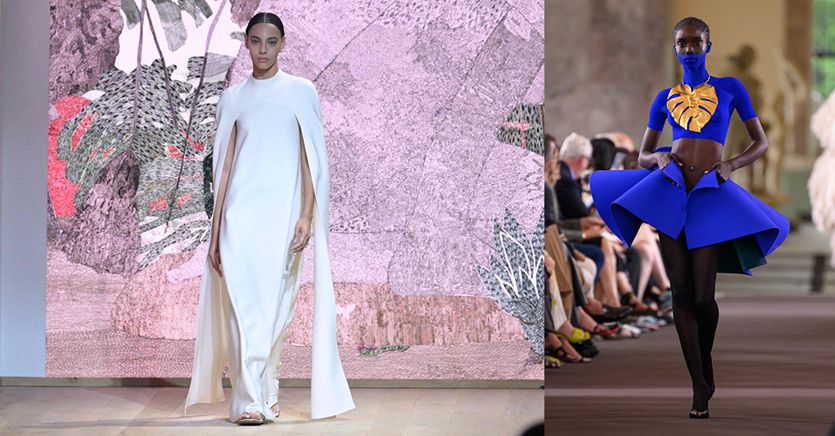Listen to the audio version of the article
The polarization on opposite and irreconcilable extremes defines the present time: all intermediate nuances disappear, from social classes to creativity, with the exacerbation that follows. The Parisian couture week opened yesterday under the banner of all or nothing, uncontrolled excess or hieratic simplification, realism or escape. Paradoxically, the higher the know-how of the ateliers, the more the apparent subtraction manifests itself in all its force. Adding is too easy, too simplistic.
The way in which Daniel Roseberry does it at Schiaparelli almost softens, since it is naive: dresses like palettes, nudity painted in Klein blue, macro locks and various surrealisms – with a lot of Gaultier and equally Lacroix thrown into the fray, without particular grace. After a sculptural and sensually severe interlude that lasted just a few seasons, Roseberry returns to experimenting and exceeding, certainly in favor of social networks and thinking of Elsa’s relationship with artists, but forgetting that clothes are not furnishings, they are not just visual objects. To dress women every day there is prêt-à-porter, of course, but here the theater gets a little carried away, and the coherence of the story goes astray. The eye enjoys it, for sure, but it soon satisfies itself. Paradoxically, the metaphorical satiety looms large also at Dior, where Maria Grazia Chiuri clearly states “The more I advance in my path, the more I take away, I subtract, I eliminate” and it is produced in a test of magnificent, monkish simplicity – not too far from what acted like Valentino – which is the natural progression of a process of purge experienced over time. His clothes are real, to be worn, and for this reason they are appreciated. In this round even the embroideries are subtractions: high operations of “sfilato”, or decorations obtained, in fact, by removing the warp or weft from the textures. Everything is long, light, draped, pale, and skilfully executed, but the effect is monotonous. Such simplicity, perhaps, becomes opaque in the frame of the classic fashion show even if the scenic box, a pantheistic sequence of embroidered goddesses, the work of the artist Marta Roberti, is moving.
Thom Browne celebrates twenty years in business with a one-off couture show held on the stage of the Opera Garnier and is cryptic, repetitive, exhausting as expected, but also affirmative of a code that has made gray and repetita juvant mantra. It’s all a succession of uniforms, straight and plump or curved like bells, which explore the infinite shades of gray through inlays and embroideries, essentially finding an unbalanced and pounding balance between excess and subtraction, with no small amount of camp, and even more childishness, and a lot of humour. Finally, Giambattista Valli parades at home, or in the new, muffled, candid headquarters of the maison, on Boulevard de Capucines. Even the collection is pervaded by a sense of domesticity, or perhaps better by a powerful calm. From the sculptural volumes to the bows to the vertical lines, it is all a reaffirmation of Valli-thought, without ostentation, without preciousness, in search of a classicism that ipso facto coincides with modernity.
